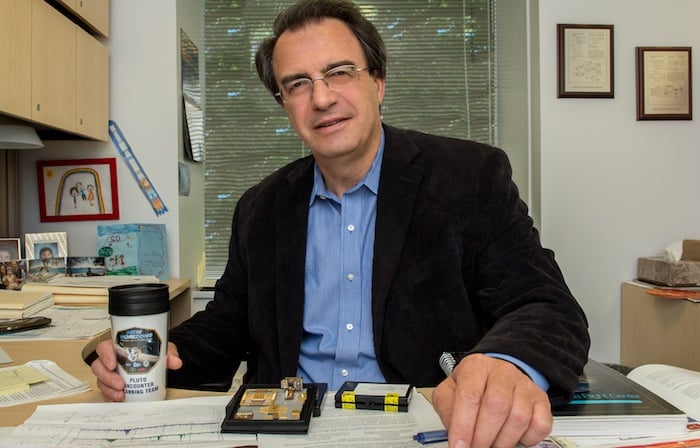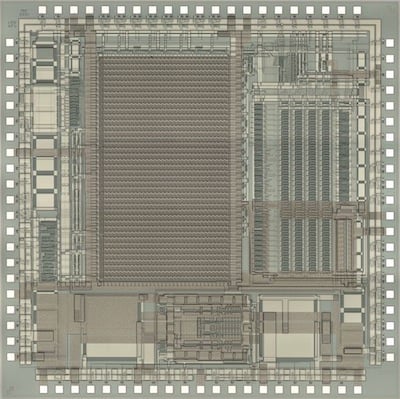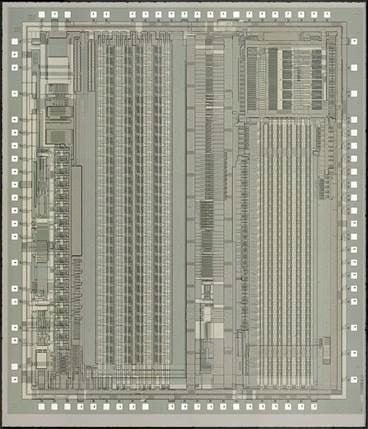
“We have been waiting for this for a long time,” said the Greek native, who now works as the Chief Technologist of the Heliophysics Division at NASA’s Goddard Space Flight Center in Greenbelt, Maryland. “That’s what happens when it takes more than nine years to get to your destination.”
When employed by the Maryland-based Johns Hopkins Applied Physics Laboratory (APL), which is operating the New Horizons mission for NASA, Paschalidis designed five application-specific integrated circuits — some U.S. patented — for the mission’s Pluto Energetic Particle Spectrometer Science Investigation (PEPSSI), developed by APL.
The instrument, one of seven flying on New Horizons, is designed to measure the composition and density of material, such as nitrogen and carbon monoxide, which escapes from Pluto’s atmosphere and subsequently is ionized by solar ultraviolet light. The atmospheric chemicals pick up energy from the solar wind and stream away from Pluto.
Until now, knowledge about the mysterious planet’s atmosphere has come mainly from stellar occultation, when the planet passes in front of bright stars during its highly elliptical-shape orbit around the sun. From these observations, scientists discovered that the planet’s atmosphere resembled that of Neptune’s moon, Triton. Although Triton is more massive than Pluto, Pluto’s atmosphere is thicker and, like Triton’s, likely consists of clouds and winds.
During its flyby, the New Horizons mission will use its onboard suite of instruments — three optical, two plasma, a dust sensor, and a radio science receiver/radiometer — to take images and spectroscopic measurements to learn more about Pluto’s atmospheric structure, composition, and temperature, as well as its surface geology and composition.
Microchips Enable Small Size
Of the payload, PEPPSI is the most compact at just 3.3 pounds (1.5 kilograms). In fact, it’s the most compact, lowest-power energetic particle spectrometer flown on a space mission, Paschalidis said.
“The challenge with this mission, and the PEPSSI instrument in particular, was making it as small as possible, capable of taking highly reliable measurements using low power, under extreme environmental conditions” Paschalidis recalled.

As with all “time-of-flight” particle instruments, particles will enter PEPSSI’s sensor and knock secondary electrons from a thin foil. They then will zip toward another foil placed about two inches away before hitting solid-state detectors. The instrument uses just 2.5 watts of power to measure the time between the foil collisions, with an accuracy exceeding one nanosecond. This information will reveal the particle’s speed and its total energy when it collides with the solid-state detector. From this, scientists will be able to determine the mass and energy of each particle.
Paschalidis’s five microchips helped reduce the instrument’s overall size and power requirements, while advancing science performance. Two in particular advanced the capabilities needed to take time-of-flight, energy, and look-angle measurements of particles, while another not only monitored and digitized PEPSSI’s and main imager LORRI’s temperatures, voltages and currents, but also those of several spacecraft subsystems, reducing mass and power so critical for the mission itself. “This set of chips was an innovation. It combined science with engineering,” resulting in significant spacecraft mass and power savings,” Paschalidis said.
“A mission to Pluto was the ultimate use for the technology,” he added. “Without these chips, I don’t think we could have put this instrument on the spacecraft.”
Technology Infusion
Although he has waited nearly 10 years to witness his technology in action as New Horizons investigates the last known unexplored planetary body in the solar system, he already knows his microchips will work. The first indication came one year after launch during New Horizon’s Jupiter encounter. “PEPSSI collected excellent data,” Paschalidis said.

While New Horizons was racing across the solar system for its rendezvous with Pluto, Paschalidis was infusing the technology into many other instruments and missions. His microelectronic technology was used on NASA’s MESSENGER spacecraft, which studied the planet closest to the Sun — Mercury — and the Interstellar Boundary Explorer that probed the heliospheric boundary with the interstellar medium – and the two STEREO spacecraft orbiting the Sun and viewing the Sun-Earth system in 3D.
He also used a second-generation version of the technology on NASA’s JUNO mission, which is expected to reach Jupiter next summer, the now-operating Van Allen Probes, and the recently launched Magnetospheric Multiscale mission. Now under development, NASA’s Solar Probe and the European Space Agency’s Solar Orbiter missions also will fly the technology.
“The New Horizons and MESSENGER/Solar Probe missions represent the two solar-system extremes of fire and ice, and the JUNO/Van Allen Probes represent the extremes of space radiation, with the others in between,” Paschalidis said. “But New Horizons drove innovation for ultra-miniaturized, low-power, and highly reliable instruments and spacecraft systems. I can’t wait to see this probe finally reach its destination after all these years. Gathering data at Pluto was something that really motivated me.”
See all the latest news from Greece and the world at Greekreporter.com. Contact our newsroom to report an update or send your story, photos and videos. Follow GR on Google News and subscribe here to our daily email!



